-
Countries
-
Data and Analysis
-
Special Focus
-
Crisis Responses
Flow Monitoring
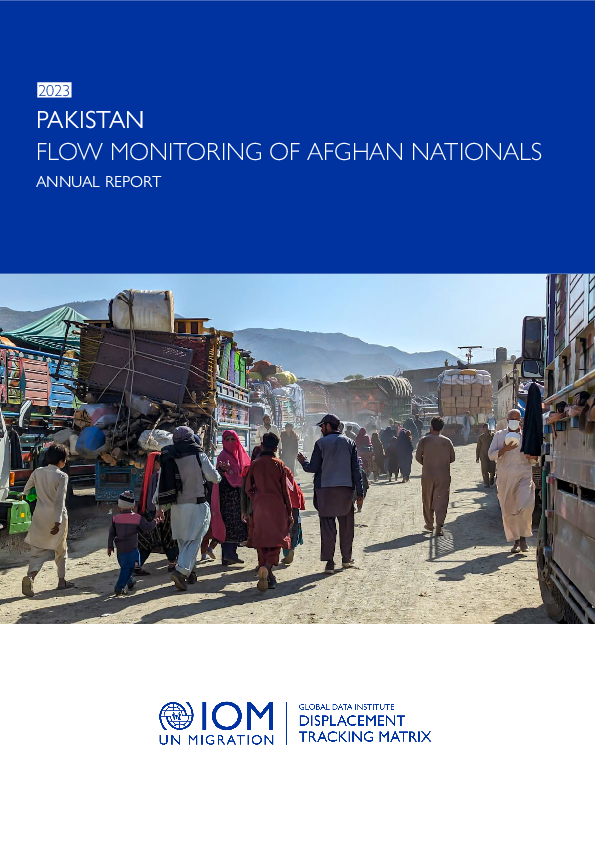
Contact
DTMPakistan@iom.int
Language
English
Location
Pakistan
Period Covered
Jan 01 2023
Dec 31 2023
Activity
- Flow Monitoring
This report presents a comprehensive analysis of the movement trends involving Afghan returnees from Pakistan. The assessment was conducted from January to December 2023 and employs the Displacement Tracking Matrix (DTM) methodology across several Border Crossing Points (BCPs) to analyse movement trends of Afghan returnees from Pakistan. IOM collected data from 23,860 household heads, representing 558,212 Afghan nationals.
The report highlights the significant increase in the number of returnees following the enactment of Pakistan's "Illegal Foreigners’ Repatriation Plan (IFRP)," which led to a marked spike in movements during the fourth quarter of 2023. It also details the demographics and vulnerabilities of the returnees, showing that a substantial number are undocumented or hold invalid documentation.
Additionally, the report examines the socio-economic impacts on the returnees, such as changes in their source of income and types of residence before and after their return. It further notes the challenges returnees anticipate in Afghanistan, including finding employment, securing shelter, and reintegrating into society.
Contact
iomyemendtm@iom.int
Location
Yemen
Activity
- Flow Monitoring
- Mobility Tracking
- Baseline Assessment
Period Covered
Mar 01 2024 -Mar 31 2024
In March 2024, IOM Yemen DTM recorded 1,930 migrants entering Yemen, an increase of 11 per cent compared to last month (1,744). Shabwah typically serves as an entry point for migrants departing from Somalia and rarely sees migrants departing from Djibouti due to the considerable distance between Djibouti and Shabwah. Thus, Shabwah was the arrival destination for 93 per cent of migrants departed from Bari, Somalia (1,800). The overall number of migrants entering through Shabwah has increased by three per cent in March (1,800) compared to February 2024 (1,744). Moreover, the team in Abyan governorate recorded new migrants landing in Ahwar district - Hesn Balead FMP. The number of migrants arriving through Abyan coast reached to 130 (all departed from Somalia).
According to DTM, conflict-induced movements constituted 57 per cent of all incoming movements in March 2024. These movements were exclusively observed in Shabwah, originating from Bari, Somalia (21% children, 23% women, and 56% men).
DTM observed an increase in Yemeni returnees by 36 per cent in March (4,226) compared to February (3,116). Furthermore, in March 2024, a total of 411 migrants ( 385 Ethiopian, 25 Yemeni, and one Somali) were deported from Oman back to Hawf district of Al Maharah governorate, Yemen.
The deteriorating humanitarian crisis in Yemen has forced many migrants to make the difficult decision to return to their home countries in the Horn of Africa. Others are reported to have been deported by authorities. DTM recorded that in March 2024, a total of 1,174 migrants either opted to take the risky journey back or were deported by boat from Yemen. This group consisted of 91 per cent men, seven per cent women, and two per cent children.
Additionally, the Djibouti DTM team documented that during the same period, a total of 1,177 migrants (92 per cent men, four per cent women, and four per cent children) embarked on a dangerous journey back home by boat from Yemen. These numbers highlight the significant challenges faced by migrants in Yemen and the desperate situations that have driven them to undertake perilous voyages across the sea.
Population Groups
Survey Methodology
Unit of Analysis Or Observation
Type of Survey or Assessment
Keywords
Geographical Scope
Administrative boundaries with available data
The current dataset covers the following administrative boundaries
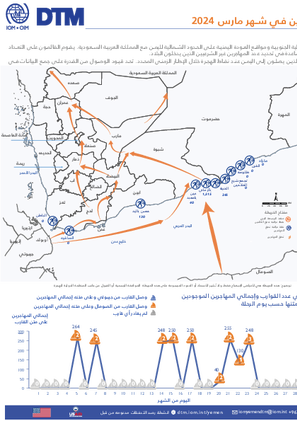
Contact
DTM Yemen, DTMYemen@iom.int
Language
English
Location
Yemen
Period Covered
Mar 01 2024
Mar 31 2024
Activity
- Flow Monitoring
- Mobility Tracking
- Baseline Assessment
يقوم سجل مراقبة التدفق التابع لمصفوفة تتبع النزوح (FMR) التابع للمنظمة الدولية للهجرة في اليمن بمراقبة وصول المهاجرين على الحدود الساحلية الجنوبية ومواقع العودة اليمنية على الحدود الشمالية لليمن مع المملكة العربية السعودية. يقوم القائمون على التعداد الموجودون في نقاط مراقبة التدفق بتسجيل المهاجرين الوافدين والمواطنين اليمنيين العائدين لتحديد أنماط الهجرة المختلفة، ولتقديم تقديرات كمية للمساعدة في تحديد عدد المهاجرين غير الشرعيين الذين يدخلون البلاد.
لا تمثل الهجرة القسرية جميع التدفقات في اليمن وينبغي فهمها على أنها مؤشر فقط لاتجاهات الهجرة للعدد الإجمالي غير المعروف للمهاجرين الذين يصلون إلى اليمن عند نقاط الهجرة خلال الإطار الزمني المحدد. تحد قيود الوصول من القدرة على جمع البيانات في بعض نقاط وصول المهاجرين.
وفي محاولة للحد من تدفق المهاجرين الداخلين إلى اليمن، والذي يعبر البلاد بشكل أساسي متجهاً نحو المملكة العربية السعودية ودول الخليج الأخرى، بدأت حملة عسكرية مشتركة في أغسطس 2023. ركزت هذه الحملة على ساحل محافظة لحج، نقطة دخول مهمة لعدد كبير من المهاجرين (بحد أقصى 15,714 مهاجرًا في مارس 2023). احتجز الجيش المهربين وطارد قواربهم، مما أدى إلى انخفاض مطرد في تدفق المهاجرين عبر هذا الساحل حتى توقف تماما خلال الأشهر الخمسة الماضية، مع استثناء واحد في منتصف ديسمبر/كانون الأول 2023 عندما تمكن قارب يحمل 110 مهاجرين من الوصول إلى الساحل. أرض.
في مارس 2024، سجلت مصفوفة تتبع النزوح التابعة للمنظمة الدولية للهجرة في اليمن دخول 1,930 مهاجرًا إلى اليمن، بزيادة قدرها 11 بالمائة مقارنة بالشهر الماضي (1,744). تعتبر شبوة عادة نقطة دخول للمهاجرين من الصومال ونادرا ما تشهد مغادرة المهاجرين من جيبوتي بسبب المسافة الكبيرة بين جيبوتي وشبوة. وهكذا، كانت شبوة وجهة وصول 93 في المائة من المهاجرين المغادرين من باري، الصومال (1,800). ارتفع العدد الإجمالي للمهاجرين الذين يدخلون عبر شبوة بنسبة ثلاثة في المائة في مارس (1,800) مقارنة بشهر فبراير 2024 (1,744). علاوة على ذلك، سجل الفريق في محافظة أبين هبوط مهاجرين جدد في مديرية أحور - مركز حصن بلعيد. ووصل عدد المهاجرين الذين وصلوا عبر ساحل أبين إلى 130 مهاجراً (جميعهم غادروا الصومال).
وفقًا لمصفوفة تتبع النزوح، شكلت الحركات الناجمة عن النزاع 57% من جميع الحركات الواردة في مارس 2024. وقد لوحظت هذه الحركات حصريًا في شبوة، مصدرها باري بالصومال (21% أطفال، 23% نساء، 56% رجال).
ولاحظت مصفوفة تتبع النزوح زيادة في عدد العائدين اليمنيين بنسبة 36 بالمائة في مارس (4,226) مقارنة بشهر فبراير (3,116). علاوة على ذلك، في مارس 2024، تم ترحيل ما مجموعه 411 مهاجرًا (385 إثيوبيًا و25 يمنيًا وصوماليًا واحدًا) من عمان إلى مديريتي شحن وحوف في محافظة المهرة باليمن.
أجبرت الأزمة الإنسانية المتدهورة في اليمن العديد من المهاجرين على اتخاذ القرار الصعب بالعودة إلى بلدانهم الأصلية في القرن الأفريقي. وبحسب ما ورد قامت السلطات بترحيل آخرين. سجلت مصفوفة تتبع النزوح أنه في مارس 2024، اختار ما مجموعه 1,174 مهاجرًا إما القيام برحلة العودة المحفوفة بالمخاطر أو تم ترحيلهم بالقوارب من اليمن. وتتكون هذه المجموعة من 91 في المائة رجال، و7 في المائة نساء، و2 في المائة أطفال.
بالإضافة إلى ذلك، وثّق فريق مصفوفة تتبع النزوح في جيبوتي أنه خلال الفترة نفسها، انطلق ما مجموعه 1,177 مهاجرًا (92% رجال، و4% نساء، و4% أطفال) في رحلة خطيرة للعودة إلى وطنهم بالقوارب من اليمن. تسلط هذه الأرقام الضوء على التحديات الكبيرة التي يواجهها المهاجرون في اليمن والأوضاع اليائسة التي دفعتهم إلى القيام برحلات محفوفة بالمخاطر عبر البحر.
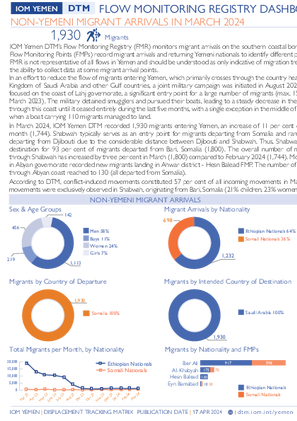
Contact
DTM Yemen, DTMYemen@iom.int
Language
English
Location
Yemen
Period Covered
Mar 01 2024
Mar 31 2024
Activity
- Flow Monitoring
- Mobility Tracking
- Baseline Assessment
IOM Yemen DTM’s Flow Monitoring Registry (FMR) monitors migrant arrivals on the southern coastal border and Yemeni return locations on Yemen's northern border with the Kingdom of Saudi Arabia (KSA). Enumerators placed at Flow Monitoring Points (FMPs) record migrant arrivals and returning Yemeni nationals to identify different patterns of migration, and to provide quantitative estimates to help define the population of irregular migrants entering the country.
FMR is not representative of all flows in Yemen and should be understood as only indicative of migration trends of the unknown total number of migrants arriving in Yemen at FMPs during the time frame indicated. Access constraints limit the ability to collect data at some migrant arrival points.
In an effort to reduce the flow of migrants entering Yemen, which primarily crosses through the country heading towards the Kingdom of Saudi Arabia and other Gulf countries, a joint military campaign was initiated in August 2023. This campaign focused on the coast of Lahj governorate, a significant entry point for a large number of migrants (max. 15,714 migrants in March 2023). The military detained smugglers and pursued their boats, leading to a steady decrease in the flow of migrants through this coast until it ceased entirely during the last five months, with a single exception in the middle of December 2023 when a boat carrying 110 migrants managed to land.
In March 2024, IOM Yemen DTM recorded 1,930 migrants entering Yemen, an increase of 11 per cent compared to last month (1,744). Shabwah typically serves as an entry point for migrants departing from Somalia and rarely sees migrants departing from Djibouti due to the considerable distance between Djibouti and Shabwah. Thus, Shabwah was the arrival destination for 93 per cent of migrants departed from Bari, Somalia (1,800). The overall number of migrants entering through Shabwah has increased by three per cent in March (1,800) compared to February 2024 (1,744). Moreover, the team in Abyan governorate recorded new migrants landing in Ahwar district - Hesn Balead FMP. The number of migrants arriving through Abyan coast reached to 130 (all departed from Somalia).
According to DTM, conflict-induced movements constituted 57 per cent of all incoming movements in March 2024. These movements were exclusively observed in Shabwah, originating from Bari, Somalia (21% children, 23% women, and 56% men).
DTM observed an increase in Yemeni returnees by 36 per cent in March (4,226) compared to February (3,116). Furthermore, in March 2024, a total of 411 migrants ( 385 Ethiopian, 25 Yemeni, and one Somali) were deported from Oman back to Hawf district of Al Maharah governorate, Yemen.
The deteriorating humanitarian crisis in Yemen has forced many migrants to make the difficult decision to return to their home countries in the Horn of Africa. Others are reported to have been deported by authorities. DTM recorded that in March 2024, a total of 1,174 migrants either opted to take the risky journey back or were deported by boat from Yemen. This group consisted of 91 per cent men, seven per cent women, and two per cent children.
Additionally, the Djibouti DTM team documented that during the same period, a total of 1,177 migrants (92 per cent men, four per cent women, and four per cent children) embarked on a dangerous journey back home by boat from Yemen. These numbers highlight the significant challenges faced by migrants in Yemen and the desperate situations that have driven them to undertake perilous voyages across the sea
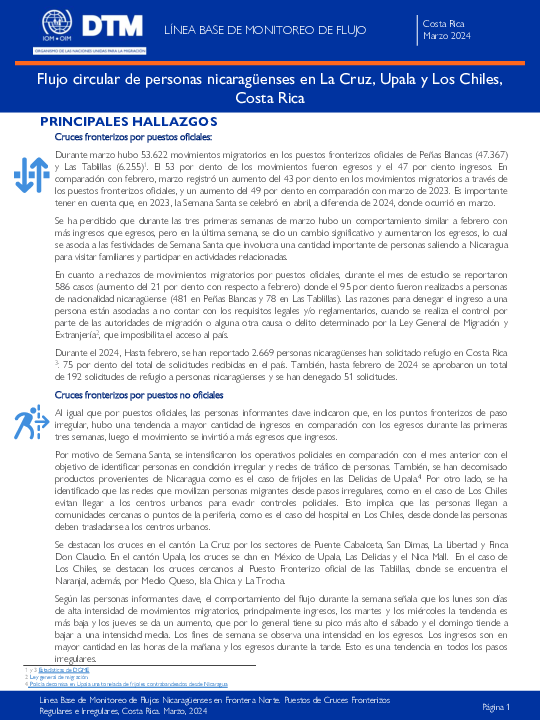
Contact
DTMCostaRica@iom.int
Language
Spanish
Location
Costa Rica
Period Covered
Mar 01 2024
Mar 31 2024
Activity
- Flow Monitoring
- Baseline Assessment
La Organización Internacional para las Migraciones (OIM), como agencia de las Naciones Unidas en materia de migración en Costa Rica, implementó, desde 2021, dos rondas de la Matriz de Seguimiento al Desplazamiento (DTM por sus siglas en inglés) como parte de su estrategia de monitoreo del flujo migratorio circular de personas de nacionalidad nicaragüense, en puntos fronterizos no oficiales, en distintos cantones del norte del país. A partir de este ejercicio en tres puntos de ingreso no oficial de la frontera con Nicaragua, se contabilizaron 60 697 movimientos migratorios, de los cuales el 59 por ciento fueron egresos y 41 por ciento ingresos.
Siendo parte fundamental de la misión de OIM brindar asesoría clave sobre políticas y prácticas migratorias, se vuelve necesario actualizar los datos de este flujo migratorio circular de nicaragüenses que cruzan tanto de forma regular como irregular la frontera norte de Costa Rica.
Según los registros de la DGME de ingresos y egresos regulares por puestos fronterizos oficiales en Los Chiles y Peñas Blancas, en 2022 hubo 394.730 movimientos migratorios regulares (50 % ingresos y 50 % egresos) mientras que durante el 2023, en total se registraron 526.271 movimientos migratorios (50 % ingresos y 50 % egresos), lo cual representó un aumento de 33 por ciento con respecto a 2022. Durante marzo de 2024, se realizaron un total de 53.622 movimientos migratorios siendo el 53 por ciento egresos y el 47 por ciento egresos.
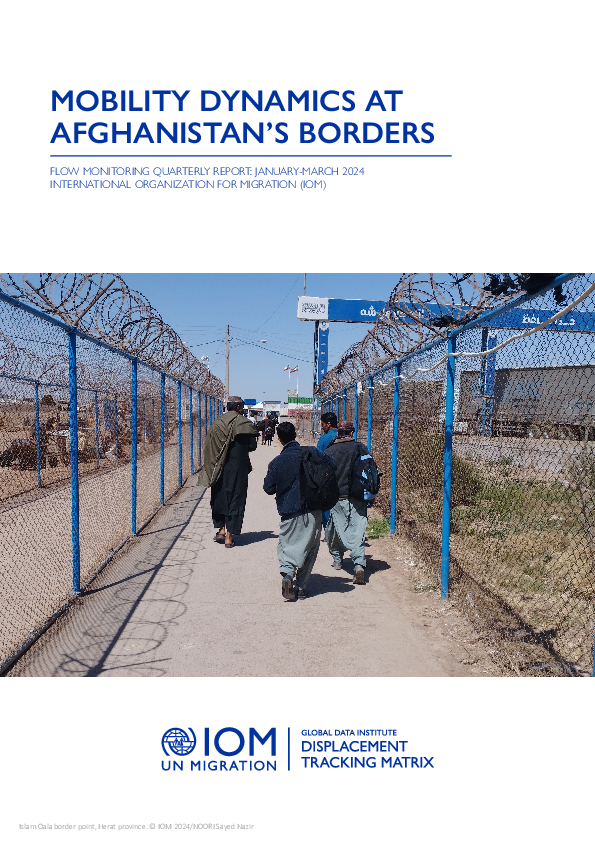
Contact
DTMAfghanistan@iom.int
Language
English
Location
Afghanistan
Period Covered
Jan 10 2024
Mar 31 2024
Activity
- Survey
- Flow Monitoring Survey
- Flow Monitoring
Over the course of decades marked by conflict, Afghanistan has experienced significant movement across its borders with neighboring countries the Islamic Republic of Iran and Pakistan. This movement, influenced by linguistic, geographical, and economic factors, has played a crucial role in shaping regional dynamics and fostering cultural ties between these countries. With 4.5 million Afghan nationals currently living in the Islamic Republic of Iran and 3.2 million currently living in Pakistan1, Afghan nationals not only seek economic opportunities, international protection and safety in these countries, but often visit family or participate in short-term travel for health and other reasons. In late 2023, policies and statements by officials in both the Islamic Republic of Iran and Pakistan called for the expulsion of undocumented foreigners, the majority of whom are Afghan nationals. Developments such as these recent policies targeting Afghan migrants have impacted movements to Afghanistan, as seen late last year when returns from Pakistan increased following the announcement of the “Illegal Foreigners’ Repatriation Plan (IFRP),” setting a deadline for unregistered or undocumented foreigners to voluntarily return to their countries or face deportation.
In response to these recent movements, IOM Afghanistan re-launched its DTM Flow Monitoring (FM) activity at the beginning of 2024 to provide critical insights into current mobility dynamics at Afghanistan’s borders. Flow Monitoring is designed to track the scale and characteristics of human mobility along the borders, including volume, intended destinations, reasons for movement, and intended lengths of stay. From January to the end of March 2024, DTM counted 567,411 individuals entering Afghanistan, 406,919 leaving Afghanistan, and interviewed 49,441 regarding their reasons for movement and intentions. The following report provides findings from DTM’s Flow Monitoring exercises for the first three months of data collection, examining trends and profiles among inflow and outflow groups to inform better targeted response mechanisms.
The report is structured in four sections. The first section, “Cumulative Flow Trends,” gives an overview of the total inflow and outflow numbers and trends between January and March. This section is linked to DTM’s Flow Monitoring Counting exercise (see details in “Methodology and Limitations”). The second and third sections, “Mobility Dynamics: The Islamic Republic of Iran” and “Mobility Dynamics: Pakistan” explore findings from interviews with people leaving and entering Afghanistan via borders with the Islamic Republic of Iran and with Pakistan, respectively. These sections are followed by “Mobility Dynamics: Conclusions” which summarizes and analyzes the findings from the interviews. These last three sections are linked to DTM’s Flow Monitoring Surveys exercise (see details in “Methodology and Limitations”).

Contact
DTM Europe, DTMMediterranean@iom.int
Language
English
Location
Republic of Moldova
Period Covered
Jan 01 2023
Dec 31 2023
Activity
- Survey
- Flow Monitoring
Key Findings:
- Among respondents, 41 per cent are active (employed or unemployed), and 53 per cent are inactive (student status, parental leave, retirement, unemployment and not looking for a job).
- Within active population, 64 per cent are employed and 36 per cent are unemployed.
- Before displacement, 81 per cent were employed and 19 per cent were unemployed.
- Top 4 sectors of employment includes: accommodation (13%), wholesale and retail (11%), education and science (10%) and human health and social work (9%)
- Satisfaction with job and skills matching is higher among men (74%) than women (71%)
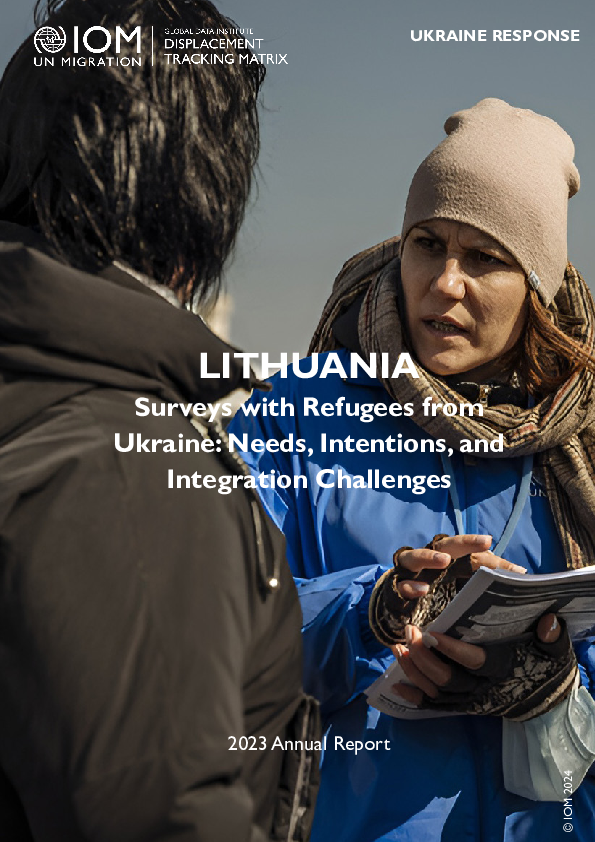
Contact
DTM Europe, DTMMediterranean@iom.int
Language
English
Location
Lithuania
Period Covered
Jan 01 2023
Dec 31 2023
Activity
- Survey
- Flow Monitoring
This report is based on a survey of displacement patterns, needs and intentions conducted by IOM’s Displacement Tracking Matrix (DTM) in the 11 countries included in the Regional Response Plan for Ukraine in 2023: 6 countries neighboring Ukraine – Belarus, Hungary, Poland, Republic of Moldova, Romania and Slovakia – and other 5 countries particularly impacted by the arrivals of refugees from Ukraine since the start of the war in February 2022 – Bulgaria, Czechia, Estonia, Latvia and Lithuania.
The analysis provided in this report is based on annual data collected from March to November 2023
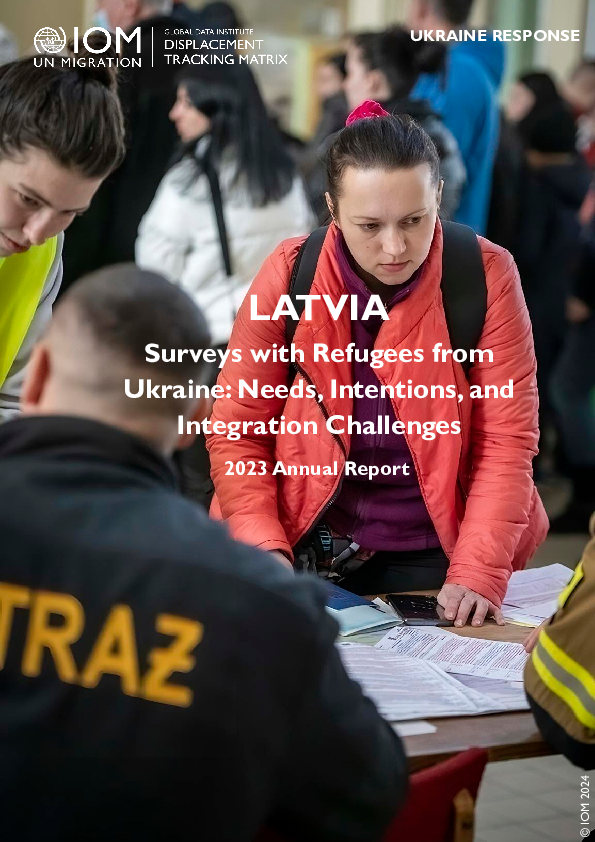
Contact
DTM Europe, DTMMediterranean@iom.int
Language
English
Location
Latvia
Period Covered
Jan 01 2023
Dec 31 2023
Activity
- Survey
- Flow Monitoring
This report is based on a survey of displacement patterns, needs and intentions conducted by IOM’s Displacement Tracking Matrix (DTM) in the 11 countries included in the Regional Response Plan for Ukraine in 2023: 6 countries neighboring Ukraine – Belarus, Hungary, Poland, Republic of Moldova, Romania and Slovakia – and other 5 countries particularly impacted by the arrivals of refugees from Ukraine since the start of the war in February 2022 – Bulgaria, Czechia, Estonia, Latvia and Lithuania.
The analysis provided in this report is based on annual data collected from January to December 2023.

Contact
DTM Haiti, dtmhaiti@iom.int
Language
French
Location
Haiti
Period Covered
Mar 08 2024
Apr 09 2024
Activity
- Survey
- Flow Monitoring Survey
- Flow Monitoring
Since end of February 2024, the security situation has deteriorated in the Metropolitan Area of Port-Au-Prince (MAPAP), the capital of Haiti. In addition to creating displacement within the MAPAP, generalized insecurity are pushing more and more people to leave the capital to find refuge in provinces, taking the risks of passing through gangs-controlled routes. In order to monitor these movements towards provinces and inform appropriate response strategies, DTM has launched data collection at several of the most used bus stations in the capital (see page 5 for more details on the methodology). In one month of implementation of this activity (since 8 March), movements of 94,821 people leaving the MAPAP have been observed (see pages 3 and 4 for more details on their profile). The majority of them (58%) took means of transport heading towards the Grand Sud departments (Grande’Anse, South, Nippes and South-East). It should be noted that this region already hosts more than 116,000 people who had in vast majority, fled the MAPAP in recent months (see the report on displacement in the Grand Sud). Half of flows headed towards 3 main destination municipalities: Jérémie (in Grande’Anse), Les Cayes (South) and Léogâne (West).
It should be emphasized that provinces do not have sufficient infrastructures and host communities do not have sufficient resources that can enable them to cope with these massive displacement flows coming from the capital.
It should be noted that at the beginning of March, when the security situation worsened, people who were already internally displaced (IDPs) were the first to begin leaving the capital. Over time, more and more people who were not IDPs are also leaving: as of 10 March, 86% of people leaving the MAPAP were IDPs. One month later, this percentage dropped to 60%, while almost 40% were those who had never fled their residence and who decide to leave it and seek refuge in provinces. This further describes the deterioration of the situation in the capital, given that leaving the capital could be a relatively quicker decision to make for a person who was already displaced than for someone who was still in their residence and decides to leave it for seek refuge in provinces.
Pagination
- Previous page
- Page 18
- Next page